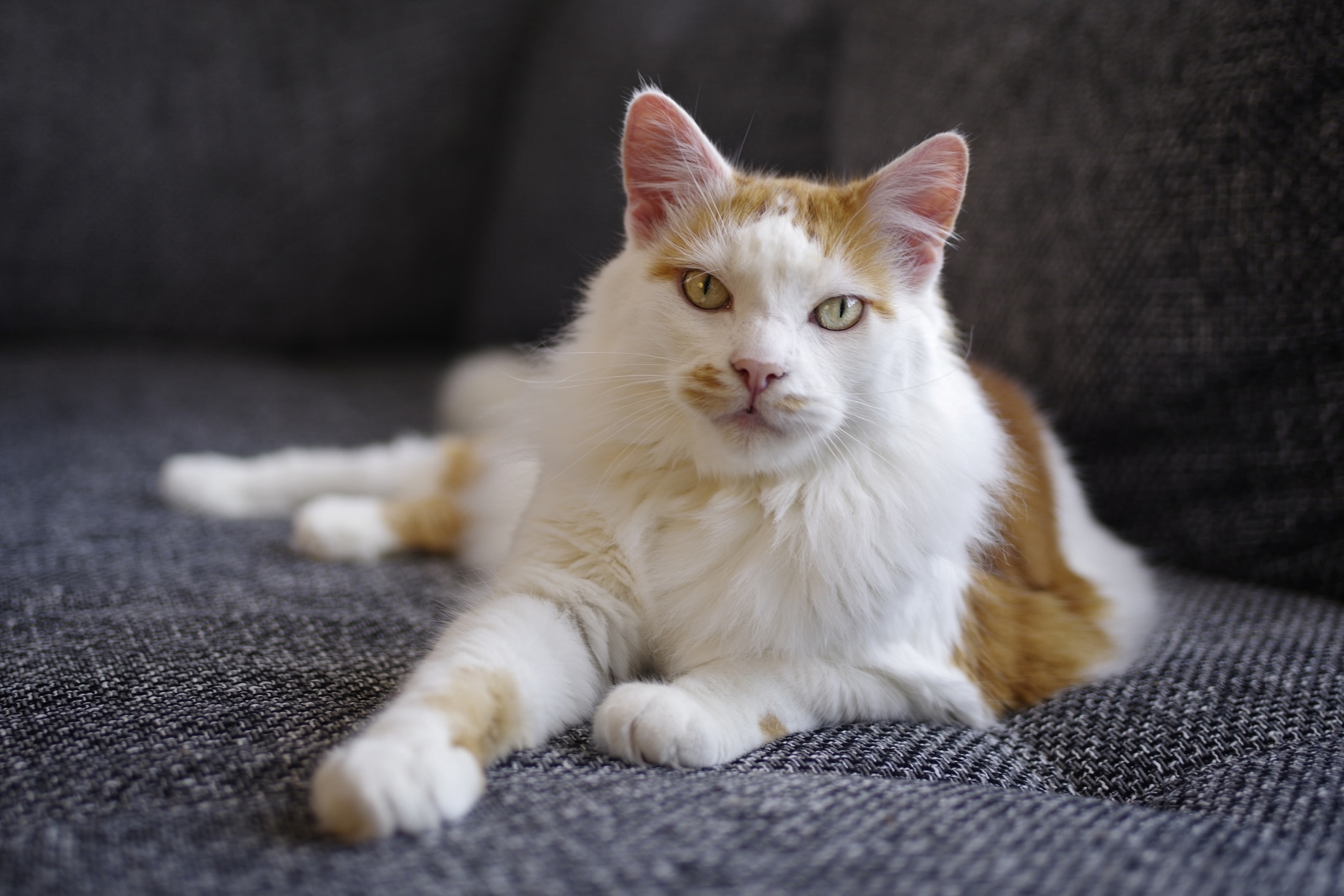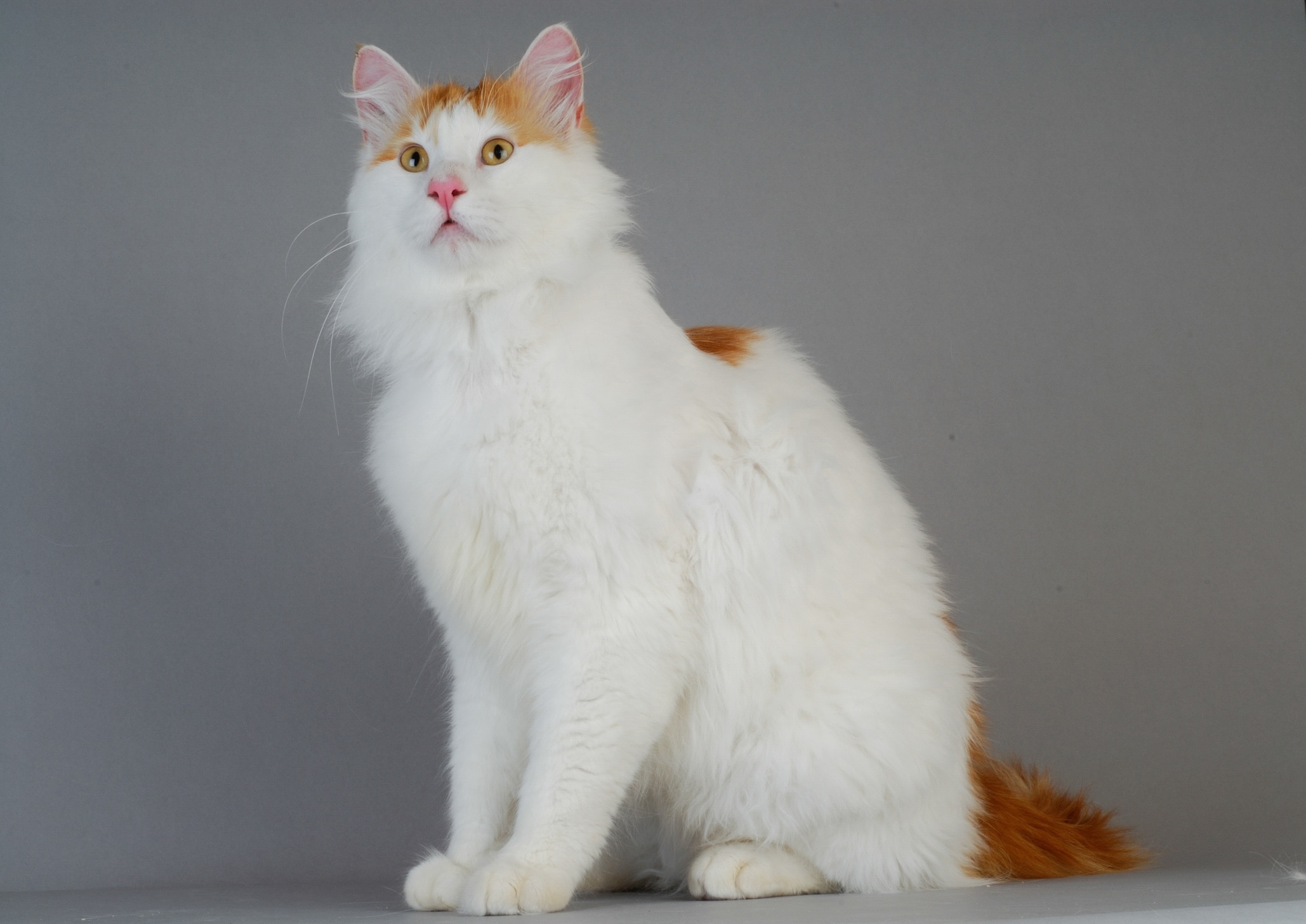Turkish Van
Andrew Linscott/iStock / Getty Images Plus via Getty Images
Turkish Van cats break feline stereotypes. Originating in the region of Lake Van, Turkey, the aptly named Turkish Van is a natural cat breed with the nickname "swimming cat" for their uncanny love of water. With almost dog-like qualities, these furballs can even be trained to fetch.
Standing 10–14 inches tall, the large Turkish Van has cashmere-soft fur and can weigh as much as 20 pounds.
Caring for a Turkish Van
Turkish Vans are active cats that love to play, jump, and climb. If you’d rather they not explore from the top of your counters and furniture, provide outlets for their energy, like cat trees, scratching posts, and wall-mounted shelves to create a vertical playground. And don't be surprised if you find them splashing in their water dish—or even attempting a dip in the tub with you.
Many cat breeds can have white coats, but some breeds, like the Turkish Van, are famous for their white coloring. In fact, “van” is a fur pattern coined from the looks of the Turkish Van: a white coat with spots of color only on the head and tail.
It’s not just the color of their fur that’s special: Turkish Van coats change more than others with the seasons. Winter brings a thick, luxurious coat with a full chest ruff and even fur between the toes. Their summer coats are short and light.
This means ample shedding between seasons. However, Turkish Vans don't have a dense undercoat, so they tend to mat less and require less frequent brushing than most longhaired cat breeds.
Turkish Van Health Issues

The Turkish Van is one of a handful of natural cat breeds, which means they developed over time through natural selection rather than by selective breeding at the hands of humans. Natural selection is a big perk for the Turkish Van; they tend to be less prone to certain health conditions that can sometimes come from selective breeding practices.
For example, while 80% of white cats with blue eyes are deaf, white-haired, blue-eyed Turkish Vans are the exception; they are typically not prone to hereditary deafness. The same can’t be said for the similar-looking Turkish Angora, which is also a natural cat breed.
Nonetheless, regular checkups with your vet are still important to prevent common cat illnesses Turkish Vans may develop.
Dental Disease
Dental disease is one of the most common conditions seen in cats. According to the Cornell Feline Health Center, as many as 90% of cats over the age of 4 have some form of the disease.
The best way to prevent feline oral issues is to brush your cat’s teeth with cat-safe toothpaste and see your vet for dental checkups and cleanings. Just like in people, dental problems can be painful, lead to bad breath, and even make your cat sick.
Obesity
About 50% of cats are overweight or obese, according to the Cornell Feline Health Center. To help your cat stay fit, provide daily interactive play; carefully portion their meals; and limit treats to no more than 10% of their total daily caloric needs.
Your vet can help determine the ideal weight for your cat and create a weight management plan, if needed.
What To Feed a Turkish Van
Turkish Vans should eat nutritional cat food. Purchasing a commercial diet with a nutritional adequacy statement saying it meets the recommendations set by the Association of American Feed Control Officials (AAFCO) means it has everything your cat needs.
Look for cat food formulated for your kitty’s age, whether they’re a kitten, adult, or senior.
How To Feed a Turkish Van
It’s recommended to feed cats two or more small meals every day. Pet parents can choose to feed their cats wet, dry, or a combination of food textures and flavors.
Avoid free-feeding your cat, as this can cause excess weight gain.
How Much Should You Feed a Turkish Van?
It can be tricky to know how much to feed your cat, but your veterinarian is there to help. They can assess your cat’s weight, activity level, and age to help create a nutrition plan that suits your cat best.
Your AAFCO-compliant cat food will also provide feeding recommendations based on your cat’s weight.
Nutritional Tips for Turkish Vans
Turkish Vans that eat high-quality cat food typically don’t require supplements. But as your cat ages, or if they develop health conditions, your vet can recommend supplements on a case-by-case basis.
Never give your cat a supplement without talking to your vet first.
Behavior and Training Tips for Turkish Vans
Turkish Van Personality and Temperament

While no two cats are exactly alike, the Turkish Van personality is often described as playful, social, and friendly.
Socializing Turkish Van kittens is important to help them feel comfortable with everyone, including other pets and children. Introduce them to dogs, new people, and other cats from a young age. Always take things slowly when introducing your cat to a new pet or person.
Turkish Vans love the company of their people, but cuddling isn't always their thing. It’s important to respect your cat’s boundaries and to teach children to do the same.
Turkish Van Behavior
Not all cats hate water, and the Turkish Van is a perfect example: They might splash in their water dish or try to join you in the shower or bathtub. In addition to encouraging hydration, a cat water fountain can be a source of entertainment for your Turkish Van.
They’re also athletic—though not always graceful—and intelligent. Without appropriate ways to play, scratch, and climb, Turkish Van cats might get creative, like scratching the couch, meowing excessively, or climbing on the counters.
Turkish Van Training
Turkish Vans are up for learning all sorts of new things, from fetching toy mice and coming when called to walking on a harness and leash. The key, as with any pet, is positive reinforcement. Keep training sessions short, fun, and reward good behavior with praise and cat treats.
Fun Activities for Turkish Vans
-
Playing fetch
-
Sunbathing on a window perch
-
Birdwatching from a catio
Turkish Van Grooming Guide
Turkish Vans are relatively low-maintenance when it comes to grooming.
Skin Care
Light-colored cats are more prone to sunburn than cats with dark fur, especially in areas that have little fur, like the nose and ear tips. While limiting their sunbathing might not be realistic, consider applying UV-blocking film to your windows for added sun protection.
Coat Care
Turkish Vans are low shedders most of the year, and their fur doesn’t tend to form mats thanks to their single coat that has a soft, cashmere-like texture.
However, they do have a blowout period when they transition from their winter to summer coats. Brushing a few times a week will help manage loose fur, while a simple weekly brushing will do for the rest of the year.
Eye Care
Turkish Vans can have blue, green, or yellow eyes. They may even have two different-colored eyes (a trait called heterochromia).
If you notice changes in your cat’s eyes, such as redness or discharge, contact your vet.
Ear Care
Head shaking, scratching the ears, and discharge are all signs of an ear infection. If you notice any of these symptoms, contact your vet.
Considerations for Pet Parents
The Turkish Van is a playful, intelligent cat that goes by the nickname "swimming cat" for its love of water. Invest in cat trees, scratching posts, and wall shelves to create a vertical playground and prevent unwanted behaviors. Even cat water fountains can be a source of enrichment.
Turkish Vans are generally a healthy breed with few known genetic health conditions. However, regular vet checkups are still important for preventive care. At-home grooming, including routine nail trims, teeth brushing, and regular brushing of their coat, will keep them healthy between vet visits.
They make wonderful companions for cat lovers who appreciate a playful and intelligent cat that breaks feline norms.
Turkish Van FAQs
Is a Turkish Van a rare cat?
Turkish Vans are a natural breed rather than selectively bred. This makes Turkish Van cats rather rare and Turkish Van cat prices quite high.
Are Turkish Van cats cuddly?
Turkish Vans aren’t known to be lap cats. However, they love being around their family members and are still considered an affectionate cat breed.
How can you tell if your cat is a Turkish Van?
Turkish Vans have a distinctive coat that’s mostly white with a dark spot (red, brown, or black) on their head and on their tail. They have a semi-long coat in the winter that changes with the seasons; it's thicker and semi-long in winter, and shorter in the summer.
